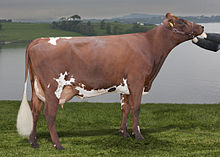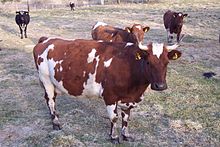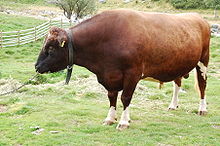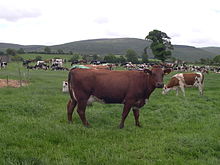Norwegian Red
 A cow | |
| Conservation status | FAO (2007): not at risk[1]: 144 |
|---|---|
| Other names |
|
| Country of origin | Norway |
| Distribution |
|
| Use | dairy |
| Traits | |
| Weight | |
| Height | |
| Coat | red-and-white, black-and-white |
| Horn status | polled or horned |
| |



The Norwegian Red or Norsk Rødt Fe[4]: 509 is a Norwegian breed of dairy cattle. It was formed in 1961 through successive mergers of various traditional and regional breeds. In 2016 it accounted for approximately 85% of the cattle in the country, and about 99% of the national dairy herd.[5]: 263
The cattle may be either horned or naturally polled; despite the breed name, the coat may be either red-and-white or black-and-white.[3]
History
[edit]The Norwegian Red is a modern composite breed. It was formed in 1961 by merging two existing Norwegian breeds, the Red Polled Eastland or Østlansk Rødkolle and the Norwegian Red-and-White or Norsk Rødt og Hvitt Fe. Each of these two was already a composite breed: the Red Polled Eastland was recorded from 1892 and later underwent cross-breeding with Swedish Red-and-White and Ayrshire, with some influence from the Dutch Black Pied;[6]: 98 the Norwegian Red-and-White, established in 1939, also derived from cross-breeding of Swedish Red-and-White and Ayrshire, but had absorbed the Hedmark and Red Troender.[6]: 88 The Red Troender, in turn, derived from cross-breeding in the nineteenth century of local Troender and Røros cattle with Ayrshire stock; it had later absorbed the Målselv (Målselvfe) breed of Tromsø and northern Norway.[6]: 98 The Dølafe, originating from local cattle of south-east Norway, Telemark (Telemarksfe) and Ayrshire, was merged into the Norwegian Red in 1963.[6]: 46 It was followed in 1968 by the South and West Norwegian or Sør og Vestlandsfe, which had been created in 1947 by fusion of the Vestland Fjord (Vestlandsk Fjordfe), the Vestland Red Polled (Vestlandsk Raudkolle) and the Lyngdal (Lyngdalsfe).[6]: 108

The Norwegian Red has been used to improve some characteristics of other dairy breeds such as the Friesian.[7][8][9]
References
[edit]- ^ Barbara Rischkowsky, Dafydd Pilling (editors) (2007). List of breeds documented in the Global Databank for Animal Genetic Resources, annex to The State of the World's Animal Genetic Resources for Food and Agriculture. Rome: Commission on Genetic Resources for Food and Agriculture, Food and Agriculture Organization of the United Nations. ISBN 9789251057629. Archived 23 June 2020.
- ^ Transboundary breed: Norwegian Red. Domestic Animal Diversity Information System of the Food and Agriculture Organization of the United Nations. Accessed April 2024.
- ^ a b c d e Breed data sheet: Norsk roedt fe / Norway (Cattle). Domestic Animal Diversity Information System of the Food and Agriculture Organization of the United Nations. Accessed April 2024.
- ^ Barbara Rischkowsky, Dafydd Pilling (editors) (2007). The State of the World's Animal Genetic Resources for Food and Agriculture. Rome: Commission on Genetic Resources for Food and Agriculture, Food and Agriculture Organization of the United Nations. ISBN 9789251057629. Archived 10 January 2017.
- ^ Valerie Porter, Lawrence Alderson, Stephen J.G. Hall, D. Phillip Sponenberg (2016). Mason's World Encyclopedia of Livestock Breeds and Breeding (sixth edition). Wallingford: CABI. ISBN 9781780647944.
- ^ a b c d e Valerie Porter, Ian Lauder Mason (2002). Mason's World Dictionary of Livestock Breeds, Types, and Varieties (fifth edition). Wallingford: CABI. ISBN 085199430X.
- ^ B.J. Heins, L.B. Hansen (2012). Short communication: Fertility, somatic cell score, and production of Normande × Holstein, Montbéliarde × Holstein, and Scandinavian Red × Holstein crossbreds versus pure Holsteins during their first 5 lactations. Journal of Dairy Science. 95 (2): 918–924. doi:10.3168/jds.2011-4523.
- ^ N. Begley, F. Buckley, K.M. Pierce, A.G. Fahey, B.A. Mallard (2009). Differences in udder health and immune response traits of Holstein-Friesians, Norwegian Reds, and their crosses in second lactation. Journal of Dairy Science. 92 (2): 749–757. doi:10.3168/jds.2008-1356.
- ^ C.P. Ferris, D.C. Patterson, F.J. Gordon, S. Watson, D.J. Kilpatrick (2014). Calving traits, milk production, body condition, fertility, and survival of Holstein-Friesian and Norwegian Red dairy cattle on commercial dairy farms over 5 lactations. Journal of Dairy Science. 97 (8): 5206–5218. doi:10.3168/jds.2013-7457.
